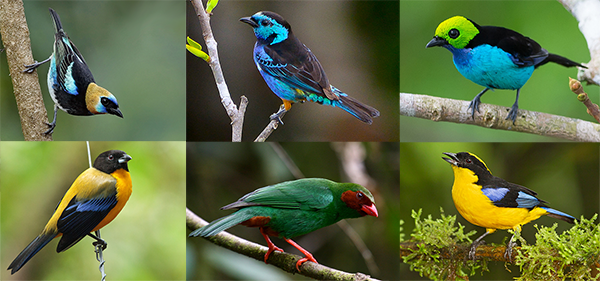The Top 10 Most Amazing Looking and Sounding Tanagers (as Determined by Science!)
By Hugh Powell June 18, 2014
In a study just out today, Cornell Lab graduate student Nick Mason examines whether birds can be both gaudy and melodious at once. Or to put it more precisely: do bird species have to make trade-offs when they evolve complex plumages and complex songs?
In the course of answering this question, Mason and his coauthors at San Diego State University had to figure out a quantitative way to measure complexity. This was a scientific study; they couldn’t just eyeball it. In the end, they measured the plumage of 303 species of tanagers using a spectrophotometer, and they analyzed 2,700 recordings of songs. The team analyzed 9 separate plumage variables and 20 song variables to develop a measure of “complexity” for both plumage and sound. Mason became the largest single user of Macaulay Library recordings in history.
When the calculations were finished and the computers had cooled off the team discovered that there seem to be no widespread constraints on the evolution of showiness. The result contradicts a long-held notion that traces back to Charles Darwin. Birds, or tanagers at least, can in fact be simultaneously beautiful and mellifluous, or drab and hoarse, or anything in between.
A happy side-effect of the research is that all that number-crunching produced actual objective rankings of these glorious (and, let’s face it, not-so-glorious) birds. So that now, thanks to modern science, we can go beyond mere gut feelings about a region’s “greatest” birds and define some quantifiable, repeatable top-10 lists. Here they are—click through to our Neotropical Birds website to see photos, and listen to their songs:
Most Complex Plumage
The study’s plumage complexity score accounted for the fact that birds’ eyes have a fourth color receptor that can see into the UV spectrum—meaning they can perceive a whole range of colors that we can’t. The complexity scores account for color brightness, plus the range of different colors a single bird shows, and other variables. “Most people would consider a cardinal to be pretty colorful,” Mason said. “but they have a kind of uniformly red coloration. That wouldn’t score as high on our index as one of the tanagers that has the whole rainbow of green, blue, red, purple.”
1. Paradise Tanager
2. Opal-rumped Tanager
3. Glistening-green Tanager
4. Blue-winged Mountain-Tanager
5. Golden-hooded Tanager
6. Green-headed Tanager
7. Black-chested Mountain-Tanager
8. Opal-crowned Tanager
9. Grass-green Tanager
10. Black-chinned Mountain-Tanager
Most Complex Songsters
Birds process sound at a much faster rate than humans can—many of the songs that were rated as complex are hard for us to even hear. “They sound like they’re just doing this little twittering thing,” Mason said. “But there are very quick changes in frequency up and down, sweeping across really long bandwidths. We can’t perceive those changes, so it sounds like a rapid chip. But the birds can actually hear that change in frequency, and it probably means something to them.”
1. Merida Flowerpiercer
2. Chestnut-bellied Flowerpiercer
3. Slaty-backed Hemispingus
4. Masked Flowerpiercer
5. Rufous-browed Hemispingus
6. Gray-bellied Flowerpiercer
7. Bananaquit
8. Lacrimose Mountain-Tanager
9. Drab Hemispingus
10. Plushcap
Simplest Plumage
1. Black Flowerpiercer
2. Sooty Grassquit
3. Large Cactus-Finch (one of the Darwin’s finches!)
4. Black-throated Grosbeak
5. Carbonated Sierra-Finch
6. White-shouldered Tanager
7. Variable Seedeater
8. Small Ground-Finch (one of the Darwin’s finches!)
9. Plumbeous Sierra-Finch
10. Slaty Finch
Simplest Songsters
1. White-bellied Seedeater
2. Yellow-winged Tanager
3. Black-winged Saltator
4. Buff-breasted Mountain-Tanager
5. Red-crested Cardinal
6. Paramo Seedeater
7. Slate-colored Grosbeak
8. Black-throated Grosbeak
9. Brazilian Tanager
10. Chestnut-bellied Mountain-Tanager
Even a casual look over these top 10 lists echoes the study’s finding that tanagers don’t seem to sacrifice one characteristic (plumage or song) in order to become more elaborate in the other. For example, two closely related mountain-tanagers appear in the “most complex” lists of both plumage (Blue-winged Mountain-Tanager) and song (Lacrimose Mountain-Tanager). That lineage has managed to excel in both areas. At the same time, Black-throated Grosbeak is on the list of both simplest plumage and simplest song. The simplicity of its plumage does not seem to have freed it to become a stronger singer, and vice versa.
“If there were going to be any group of birds at all that would show this trade-off, the tanagers would be a very good candidate, because there’s all this variation in song and plumage complexity,” Mason said. “From a holistic perspective the idea of a trade-off does seem to fit the bill. But when we dive into it and do some rigorous statistics, it turns out that there is no overall trend.”

All About Birds
is a free resource
Available for everyone,
funded by donors like you
American Kestrel by Blair Dudeck / Macaulay Library
